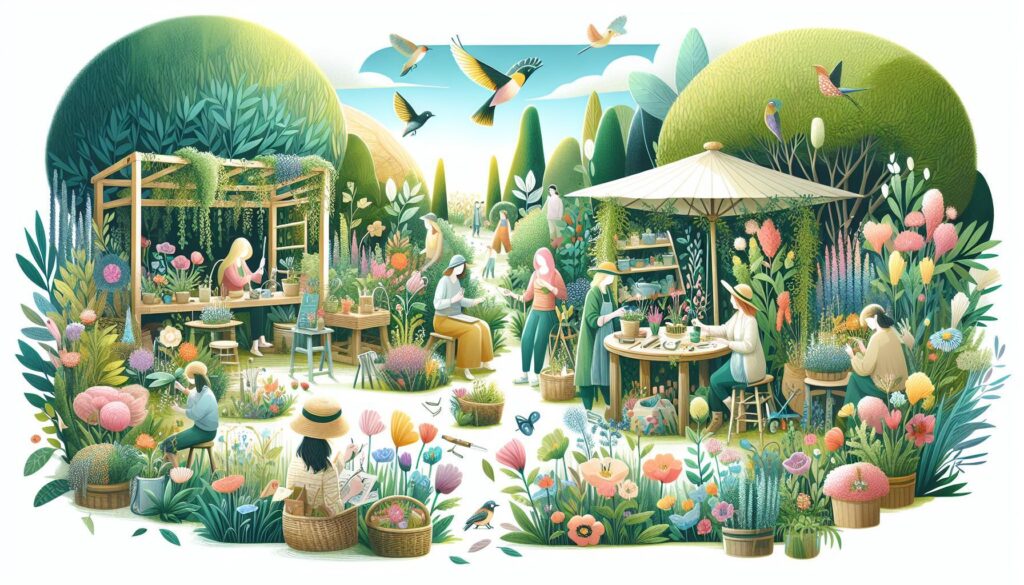Flowers That Survive the Worst Weather and Thrive Year-Round
When you think of flowers, you might picture bunches of delicate petals swaying in a gentle breeze, but what about those brave blooms that laugh in the face of frost and dance through drought? welcome to the world of “Flowers That Survive the Worst Weather and Thrive Year-Round”! These botanical superheroes are not just surviving; they’re thriving against the odds, proving that resilience comes in colors more vibrant than your average pot of geraniums. Whether you’re a seasoned gardener with a black thumb or just someone looking to add some tough beauty to your garden, this guide will introduce you to the hardiest flowers that don’t just endure the storms—they flourish because of them! So grab your watering can (and maybe a raincoat), and let’s dig into the flower power that can withstand both winter’s chill and summer’s blaze!
Understanding weather Resilience: An Insight into Hardy Flowers
When it comes to floral resilience, some species have evolved unique adaptations that allow them to weather the harshest conditions. These hardy flowers not only survive but also flourish through extreme temperatures, heavy winds, and unexpected shifts in moisture.For instance, the Alpine Gentian thrives at high altitudes, enduring low temperatures and intense UV radiation. similarly, Echinacea (or Coneflower) demonstrates amazing drought resistance, making it a popular choice for gardeners aiming to conserve water while still enjoying vibrant blooms. Other robust contenders include:
- Black-Eyed Susan – Tolerates heat and drought.
- Lavender – Thrives in poor soil and dry conditions.
- Daylily – Adapts well to various climates and is pest-resistant.
To effectively cultivate these resilient flowers, understanding their growing conditions and maintenance needs is crucial. For example, some hardy varieties prefer full sunlight and dry soil, while others may require a balance of sun and shade. A simple comparison of key characteristics can aid gardeners in selecting the right flowers for their climates:
| Flower | Sunlight | Water Needs | Climate Suitability |
|---|---|---|---|
| Alpine Gentian | Full sun | Low | Cool, alpine |
| echinacea | Full sun to partial shade | Low | Sunny, dry |
| Black-Eyed Susan | Full sun | Moderate | Warm, temperate |

Perennial Powerhouses: Flowers That Flourish in Any Climate
In the world of horticulture, certain flowers are celebrated for their incredible ability to thrive in diverse climates and conditions. These robust plants not only endure harsh weather but can also bring stunning aesthetics to any garden. Some of the most resilient flowers include:
- Daylilies – with their vibrant colors and minimal care requirements, daylilies can flourish in poor soil and withstand drought.
- Lavender – not only does it thrive in hot, dry environments, but its fragrant blooms add beauty and attract pollinators.
- Peonies – offering lush blossoms, these hardy perennials can survive frost and return beautifully each spring.
- Black-eyed Susans – known for their bright yellow petals, they are drought-resistant and can tolerate a range of soil types.
to further understand the effectiveness of these flowers in various climates, consider the following table that summarizes their climatic resilience and unique features:
| Flower | Climate Adaptability | Care Level |
|---|---|---|
| Daylily | All Zones | Low |
| Lavender | Hot and Dry | Low |
| Peony | Temperate | Moderate |
| Black-eyed Susan | Wide Range | Low |
By selecting these resilient varieties, you can create a vibrant landscape that not only survives but thrives through the challenges presented by nature. With minimal maintenance requirements together with their enduring beauty, these flowers offer a reliable choice for both novice and experienced gardeners alike.
The Science of Survival: How Certain Flowers Adapt to harsh conditions
Many flowers have evolved remarkable mechanisms that enable them to endure extreme environmental conditions. These adaptations range from physiological changes to unique reproductive strategies. As an example, desert succulents such as the agave and Aloe species have developed thick, fleshy leaves that store water, allowing them to thrive in arid climates. Similarly, the alpine aster employs a dense mat of leaves that serves as insulation against the cold, effectively lowering the temperature fluctuations within the plant and conserving vital warmth.Such adaptations highlight the intricate relationship between flora and their habitats,underscoring the importance of genetic diversity and resilience in the face of climate change.
Another engaging aspect of these resilient blooms is their reproductive strategies, which are often finely tuned to take advantage of the brief windows of favorable weather. for example, the fire lily relies on smoke from wildfires to trigger germination, allowing it to emerge rapidly after a fire clears the way for sunlight and nutrients. Additionally, plants like the lotus can thrive in murky waters, with their flowers rising above the surface, symbolizing purity and resilience. Below is a comparison of some extreme weather-adapted flowers along with their unique survival traits:
| Flower | Adaptation |
|---|---|
| Agave | Water storage in leaves |
| Alpine Aster | Insulating mat of leaves |
| Fire Lily | Germination triggered by smoke |
| Lotus | Flowers above murky waters |

Top Recommendations for Low-Maintenance Plants for Year-Round Beauty
When selecting plants that promise beauty with minimal care, consider the following resilient varieties known for their striking appearances and ability to weather harsh conditions. Sedum is a top pick, featuring fleshy leaves and vibrant flowers that attract pollinators. Another excellent choice is Lavender, which not only provides a pleasant fragrance but also endures drought and adds a lovely purple hue to any garden. For a splash of color, Black-Eyed Susans are ideal; they thrive in various soils and bloom brightly from summer to fall. Ornamental Grasses like Pampas and Blue Fescue can provide movement and texture, making them a perfect addition to any landscape while requiring little maintenance.
Additionally, consider including Daylilies in your garden, as they boast stunning blooms and are highly adaptable to different climate conditions. for those seeking evergreen beauty, Holly is perfect, offering lush foliage and vibrant red berries in winter. The following table highlights more low-maintenance options, showcasing their unique qualities:
| Plant | Color | Sun Requirement | Watering Needs |
|---|---|---|---|
| Sedum | Varies – Red, Pink | Full Sun | Low |
| Lavender | Purple | Full Sun | Low |
| Daylilies | Yellow, orange | Full to Partial sun | Moderate |
| Holly | Green, Red Berries | Partial Sun | Low |
Caring for Resilient Blooms: Essential Tips for Thriving Gardens
Creating a resilient garden that can withstand harsh weather conditions begins with selecting the right plants. Drought-tolerant flowers, such as Lavender and echinacea, not only resist extreme heat but also flourish with minimal water. These plants are well-adapted to survive dry spells, making them perfect for regions with unpredictable rainfall. Additionally, native perennials like Purple Coneflower and Black-eyed Susans provide a beautiful splash of color while requiring less maintenance, as they are naturally suited to thrive in local conditions. Ensuring proper soil preparation can significantly enhance plant resilience; consider incorporating organic matter to improve soil structure and water retention capabilities.
Proper placement of your chosen blooms is crucial for their long-term success. Positioning them in areas where they receive adequate sunlight while being shielded from fierce winds can make a notable difference. Here are some additional tips to ensure your garden flourishes in any condition:
- Mulch: Applying a layer of mulch can help retain moisture and suppress weeds.
- Water Wisely: Deep, infrequent watering encourages deeper root growth.
- Pest Management: Employing natural pest control methods will help keep your flowers healthy.
| Flower Name | Condition Tolerance | Bloom Period |
|---|---|---|
| Lavender | Drought, Heat | Summer |
| Echinacea | Drought, Poor Soil | Summer to Fall |
| Black-eyed Susans | Heat, Humidity | Summer to Early Fall |
Creating a Weather-Resistant Garden: Designing with Tough Flowers
When designing a weather-resistant garden, choosing the right flowers is crucial for ensuring a vibrant landscape that can withstand nature’s challenges. Consider incorporating perennials that boast resilience against harsh conditions. Notable options include:
- daylilies – Adaptable and colorful, they thrive in varied climates.
- Black-eyed Susans – These bright blooms can tolerate drought and are known for attracting pollinators.
- Lavender – This aromatic flower not only survives dry spells but also adds beauty and fragrance.
- Sedum – Low-maintenance and drought-resistant, sedum varieties provide excellent ground cover.
Moreover, incorporate flowers that can handle both heat and cold variations. Some exceptional choices are:
| Flower | Cold Resilience | Heat Tolerance |
|---|---|---|
| Coneflower | Hardy to Zone 3 | Thrives in heat |
| Russian Sage | handles frost | Heat-drought tolerant |
| Bee Balm | Survives cold | Resilient in heat |
By carefully selecting and planting these tough flowers, you can create a stunning garden that not only endures the worst weather but also thrives year-round, providing color and life to your space in every season.
Seasonal Highlights: What to Expect from Year-Round Blooms
When planning your garden, its crucial to consider plants that can withstand fluctuating climates while still offering vibrant blooms throughout the year. Some flowers are especially adept at enduring harsh conditions, from frigid winters to scorching summers. Perennials like Black-eyed Susans and Daylilies not only survive but thrive across various seasons, providing bursts of color even when other species wither. Additionally, the hardy Sedum and Coneflower stand out for their resilience, showcasing unique textures and shades that add depth to any landscape.
Incorporating a mix of these enduring blooms into your garden can yield stunning results through every season.Consider designing an arrangement with evergreen shrubs paired with flowering plants, ensuring visual interest year-round.A suggested pairing includes the Winterberry with Hellebores and Tulips. below is a simple table highlighting some of the best year-round bloomers to consider:
| Flower Type | season of Bloom | Hardiness Zone |
|---|---|---|
| Black-eyed Susan | Summer to Fall | Zones 3-9 |
| Daylily | Summer | Zones 3-10 |
| Coneflower | Summer to Fall | Zones 3-9 |
| Hellebores | Winter to Early Spring | Zones 4-9 |
Selecting Native Varieties: Benefits of Local Flora in Extreme Environments
Selecting native plant varieties is crucial, especially when cultivating flora in extreme environments. These plants have evolved over millennia, adapting to local climatic conditions and soil types, which grants them a remarkable resilience against harsh weather. By choosing native species, gardeners and landscapers not only ensure a higher survival rate but also promote biodiversity within their ecosystems. For instance, in arid regions, native succulents and drought-resistant shrubs require less water, thriving even during prolonged dry spells. Similarly, in areas prone to heavy snowfall or ice, robust perennials like native asters and coneflowers can withstand the weight, ensuring a vibrant landscape all year round.
Beyond their resilience, native plants provide several ecological benefits that contribute to the overall health of the environment. They offer critical habitats for local wildlife,including pollinators such as bees and butterflies that are essential for maintaining balanced ecosystems.Additionally, many native varieties possess deep root systems that enhance soil stability and prevent erosion, particularly in areas prone to flooding. by planting native flora, communities can collectively combat climate change, preserve water resources, and foster a sustainable relationship with nature. Some excellent examples of native plants that flourish in extreme settings include:
- Black-eyed Susan – Thrives in sunny locations and poor soil.
- Western Aster – Highly resilient against frost and drought.
- Prairie Dropseed – A grass that tolerates drought and supports local wildlife.
- Mountain Laurel – Tolerates rocky, acidic soil commonly found in mountainous areas.
| Plant Name | Adaptation | Benefits |
|---|---|---|
| Black-eyed Susan | drought-tolerant | Pollinator attraction |
| Western Aster | Frost resistance | erosion control |
| Prairie Dropseed | Deep-rooted | Wildlife habitat |
| Mountain Laurel | Adaptable to rocky soil | Shade tolerance |
Q&A
What are some of the most resilient flowers that can withstand harsh weather conditions?
several flowers are known for their resilience in the face of extreme weather conditions. A few standout examples include the Helleborus (commonly known as Lenten Rose), Echinacea (purple coneflower), and Sedum (stonecrop).These plants not only survive but thrive in various climates, demonstrating remarkable hardiness.the Lenten Rose is particularly notable for blooming in late winter to early spring, even poking through the snow. it can tolerate frost and drought, showcasing its adaptability. On the other hand, Echinacea is renowned not only for its beauty but also for its ability to attract pollinators, making it a fantastic choice for biodiverse gardens. sedum, with its succulent leaves, can withstand dry conditions and poor soil quality, often flourishing in rocky areas where other plants may struggle.
How can I choose flowers that thrive year-round in challenging climates?
Choosing flowers that can thrive year-round in challenging climates involves understanding your local climate conditions, including temperature ranges, rainfall patterns, and soil types. It’s essential to select native or adapted species that have evolved to endure local weather extremes. Consulting plant hardiness zones can be very helpful; such as, USDA Hardiness Zones categorize plants based on their ability to withstand cold temperatures.
When selecting plants,consider the specific needs of your garden space. As a notable example, Lavandula (lavender) is not only drought-resistant but also prefers hot, dry conditions, making it ideal for warmer climates. Meanwhile, Daylilies are adaptable and can thrive in various conditions, ranging from sandy soils to heavier clay. Drought-tolerant varieties and perennials like Black-eyed Susans or Bee Balm are also excellent choices that can return year after year with minimal care.
Are there specific growing techniques to enhance the survival of these resilient flowers?
Yes, certain growing techniques can significantly enhance the survival and longevity of resilient flowers. One of the most effective methods is to ensure proper soil preparation. Optimally, the soil should have good drainage, as excessive moisture can lead to root rot, especially in tough climates. Adding organic matter such as compost can improve soil structure and nutrient retention, promoting stronger root systems.
Another essential technique is mulching, which helps to regulate soil temperature and retain moisture. A layer of organic mulch, like wood chips, not only suppresses weeds but also protects perennials during extreme weather fluctuations. Additionally, consider implementing companion planting strategies, where resilient flowers are planted alongside other plants that may benefit from their presence. This can create a more supportive garden ecosystem, making it easier for all plants to thrive even under adverse conditions.
What type of maintenance do hardy flowers require throughout the year?
Hardy flowers typically require lower maintenance compared to more delicate varieties, but some care is still essential to ensure they remain healthy and vibrant.Watering practices should focus on providing deep,infrequent watering rather than frequent shallow watering,which encourages surface root growth. During prolonged dry spells, it’s helpful to monitor soil moisture levels, especially for newly planted flowers.
Seasonal maintenance tasks include pruning dead flowers and foliage after blooming to encourage healthy growth and airflow. Dividing perennials every few years can also help maintain their vigor and prevent overcrowding. It’s important to fertilize sparingly; many hardy flowers thrive in less nutrient-rich soils, so a balanced organic fertilizer every season is often sufficient. Observing each plant’s individual needs will help guide your maintenance throughout the year.
Are there any environmental benefits to planting flowers that survive extreme weather?
Absolutely! Planting flowers that can survive extreme weather offers numerous environmental benefits. first, these resilient plants frequently enough require less water compared to non-native or delicate varieties, making them ideal in areas facing drought conditions. this water conservation translates to less demand on local water supplies and promotes sustainable gardening practices that can definitely help address climate change challenges.
Moreover, hardy flowers frequently support local ecosystems. Many of these plants are pollinator-friendly, attracting bees, butterflies, and other beneficial insects, which are essential for healthy ecosystems and biodiversity. For example, Echinacea not only beautifies gardens but also serves as a vital resource for pollinators. Additionally, planting native or climate-resilient flowers can help stabilize soils, reduce erosion, and improve air quality, contributing positively to the environment. Thus, by choosing resilient flowers, gardeners can actively participate in ecological conservation efforts.
The Conclusion
embracing hardier flowers that can withstand extreme weather conditions not only enhances the resilience of your garden but also ensures vibrant blooms year-round. From the dazzling resilience of Echinacea to the steadfastness of Sedum, these botanical champions have proven their worth against the elements, thriving through blizzards and scorching sun alike.
By selecting these robust varieties, you can create a flourishing landscape that remains visually appealing and environmentally sustainable, nonetheless of seasonal fluctuations. As you plan your garden, consider integrating these resilient flowers into your design. They not only bring beauty but also attract pollinators and contribute positively to the ecosystem. With the right knowledge and careful selection, you can cultivate a garden that not only survives but thrives—no matter the weather. Happy gardening!



